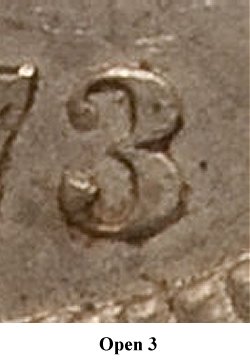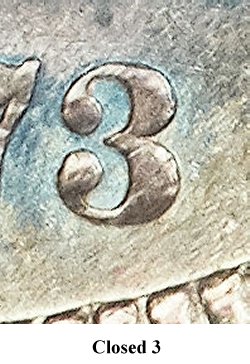

|
|
|
1873 No Arrows Liberty Seated Quarter Dollar - Closed vs. Open 3
by Greg Johnson
The year 1873 marked the end of the Liberty Seated Half Dimes and Dollars. The dime, quarter and half dollar denominations underwent a weight change during the year as part of the same law. The change, which was implemented after coinage production had begun for the year, was denoted by arrows added on either side of the date of the “new” weight coins. Quarters minted by the Philadelphia and Carson City mints during 1873 are thus one of two types – with arrows and without arrows. The without or “no arrows” Philadelphia quarters are further subdivided into two significant varieties denoted as “open 3” and “closed 3” – referring to the spacing of the knobs of the 3 in the date.
The business strike 1873 no arrows closed 3 quarter
is a quite rare and popular variety amongst seated quarter collectors. Most
known examples are low grade and/or have problems. Problem free examples of
this variety are excessively rare in XF or better. The finest known specimen
(NGC MS63) of the variety sold for a record $74,750 in Heritage FUN 1/2008:2785. Back
to Quarter of Month Topic List 

Lurking in the shadow of its more famous sister, and apparently quite under
appreciated, is the no arrows open 3 variety. Though relatively common in low
grades by seated quarter standards, it becomes very scarce to rare in XF and
better grades. The grading services (PCGS and NGC) have graded a total of 69
no arrows open 3 quarters in all grades compared to 34 no arrows closed 3 examples.
Interestingly, the differences are accounted for almost entirely by mint state
coins. PCGS, for example, has graded 23 open 3 versus only 2 closed 3 coins
in mint state. This is in contrast to the circulated grades where there are
actually more closed 3 specimens graded by PCGS than open 3 coins. One must,
as always, take population report numbers with a grain of salt as there is greater
incentive to encapsulate rarer coins, and crossovers and resubmissions are not
accounted for in the reports. (Confession - I personally have owned two 1873
no arrows open 3 examples which account for 4 of the 69 grading events appearing
in the population reports.)
The situation becomes more interesting if one considers the proofs minted in
Philadelphia during 1873. Though correctly considered a different issue from
business strikes, many collectors, including Eliasberg, have substituted relatively
common proofs for very rare business strikes in their sets. All 600 proof quarters
minted in 1873 were of the closed 3 variety and are challenging to distinguish
from high grade business strikes. PCGS and NGC have certified over 300 of these
no arrows closed 3 proofs. The survival estimates in Briggs’ Comprehensive
Encyclopedia of United States Liberty Seated Quarters suggest that around 140
business strike no arrows closed 3 quarters exist in all grades combined. Though
there are many hundreds of low grade (below VF) no arrows open 3 quarters, estimates
suggest that Choice VF and better examples exist in similar numbers (i.e. around
150 pieces). Though considerably more expensive, the 300+ proof no arrows closed
3 coins are apparently twice as available as VF and better business strike no
arrows open 3 examples.
There are two conclusions to be drawn from these numbers and observations. First,
a nice proof 1873 no arrows closed 3 quarter offers the set builder a less expensive
alternative to the very rare and expensive business strike. Second, the 1873
no arrows open 3 is more of a condition rarity (in choice VF and better) than
price guides seem to reflect and is a good purchase when a nice example can
be found – which isn’t very often.
The no arrows closed 3 and open 3 quarters (and other denominations) have been
written about in the Gobrecht Journal a number of times recently. Specifically,
Issue 99 p. 30 “The 1873 Closed 3 Quarter and Its Reverses” by Len
Augsburger; Issue 101 p. 49 “1873 Closed 3 Over Open 3 Comparisons”
by John McCloskey and Bill Bugert; Issue 102 p. 38 “1873 Closed 3 and
Open 3 Proof Coinage” by Bill Bugert and John McCloskey; and Issue 108
p. 3 “Reinventing the Standard Catalogue: Liberty Seated Line Drawings
from the John J. Ford Library” by Leonard Augsburger.